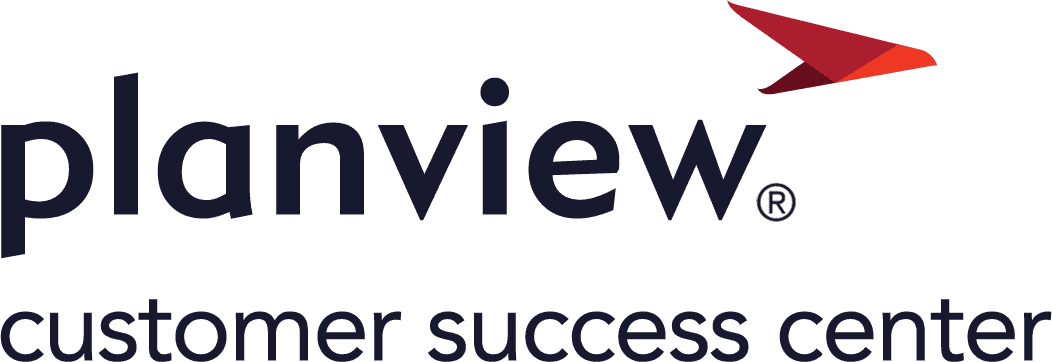Objectives and Key Results screen basics
- Last updated
- Save as PDF
The Objectives and Key Results screen shows the objectives and key results (OKRs) for a Planview AgilePlace board or for the selected strategy or work item in Planview Portfolios. On this screen, you can perform the following tasks:
- View all objectives and key results (OKRs) or filter OKRs using criteria such as date range, OKR level, name, and parent objective.
- View the progress of objectives and key results (OKRs) and key result updates.
- Create new objectives.
- Create new key results for existing objectives.
- Update the progress of key results, modify progress values, or delete progress values.
- Modify objectives and key results.
- Delete objectives and key results.
- Change OKR settings for the screen.
- Export OKR data as a Microsoft Excel file.
IMPORTANT
A new Objectives and Key Results screen is not activated until a user with edit (read/write) permissions to create strategies, work items, or boards opens the new screen. Until a user with edit permissions opens the new screen, other users will not be able to open or search for the new screen.
The screen allows you to view OKR using two views, the card view and the list view.
Using the card view
The card view is a graphical view using a card for each OKR, organized within lanes for each OKR level that is selected to be shown. Each OKR card summarizes the OKR's information with icons, numeric indicators, and relationship lines.
You can configure the card view as follows:
- Adjust the timescale (
 ) to limit the OKRs shown.
) to limit the OKRs shown. - Select and hide OKR levels (
 ).
). - Apply a filter (
 )to the screen.
)to the screen.
The following figure shows an example of the Objectives and Key Results screen in the card view:

Example of the Objectives and Key Results screen in the card view
Using the list view
The list view is a hierarchical table view that lists OKRs in collapsible and expandable rows. This format provides a comprehensive overview of your OKRs with the ability to filter and sort the list.

You can configure the list view as follows:
- To temporarily reorder the columns on the screen, you can click and drag columns to rearrange them; however, the next time you open or refresh the screen, the columns will return to their default settings.
- To change and save the column configuration, click
 > Customize list view at the top right of the Objectives and Key Results screen. Then select and clear the columns you want, click and drag to rearrange the columns, and click Save.
> Customize list view at the top right of the Objectives and Key Results screen. Then select and clear the columns you want, click and drag to rearrange the columns, and click Save. - When you open the list view for the first time, all parent objectives are shown with collapsed rows; you can then expand rows as needed by clicking
 as needed.
as needed. - Adjust the timescale (
 ) to limit the OKRs shown.
) to limit the OKRs shown. - Select and hide OKR levels (
 ).
). - Apply a filter (
 )to the screen.
)to the screen.
The following table describes the columns available in the list view.
| Column | Description |
|---|---|
| Progress | The progress value for the OKR. |
| Start date | The start date for the OKR. |
| Scope | The selected scope (AgilePlace board or Planview Portfolios strategy or work item) for an objective. |
| Last updated progress value | The most recent progress value for a key result and the date of that update. |
| Start value | The start value for a key result. |
| Target value | The end value for a key result's last target. |
| Owner | The owner of the OKR. |
| End date | The end date for the OKR. |
| Level | The selected OKR level for an objective. |
| Upcoming Target | The target value and end date for a key result's next target. |
| Custom attributes | If you have custom attributes, each attribute also appears as a column. |
Accessing the screen from AgilePlace
To navigate to the Objectives and Key Results screen:
- Access the Planview AgilePlace board.
- Click
 .
.
Accessing the screen from Planview Portfolios
In Planview Portfolios, you can access the screen from a strategy, strategy portfolio, work item, or work portfolio.+
To navigate to the Objectives and Key Results screen from a strategy portfolio:
To navigate to the Objectives and Key Results screen from a strategy:
To navigate to the Objectives and Key Results screen from a work portfolio:
To navigate to the Objectives and Key Results screen from a work item:
Using the list view
The list view (  )
)
Objectives and Key Results screen elements
OKR toolbar
The following table describes the elements in the OKR toolbar above the Objectives and Key Results screen (below the top bar).
The following table describes the elements on the Objectives and Key Results screen.
| Element | Description | |
 |
Opens the Filter pane, on which you can filter OKRs on the screen using the following options:
|
|
| New Objective |
Click to create a new objective. |
|
|
|
The timescale for the OKRs shown on the screen:
|
|
 |
(Card view only) The left-to-right sorting order within each row on the screen:
|
|
 |
Controls which OKR levels appear on the screen. Click to show or hide levels and view which level is set as the primary. |
|
 |
Shows the card view for the screen, on which OKRs appear as cards within lanes for each OKR level that is selected to be shown. For objectives, you can view connections to other objectives up to three levels above (parent objectives) and three levels below (child objectives) the selected objective. |
|
|
|
Shows the list view for the screen, on which OKRs appear in a hierarchy in a table on the screen. You can expand and collapse rows in the hierarchy to see the children of an OKR. For objectives, you can view connections to other objectives up to three levels above (parent objectives) and three levels below (child objectives) the selected objective. |
|
 |
Opens the OKR Health pane, on which you can view OKR progress and the status of key result updates and connected work items. | |
 |
Shows or hides the parent-child relationship lines between OKRs. | |
 |
The action menu for the screen. |
|
| OKR Settings |
Opens the OKR Settings screen, which has the following options:
|
|
| Customize list view | Opens the Customize list view screen, on which you can select columns to show or hide in the list view of the Objectives and Key Results screen. You can also rearrange the order of columns by clicking and dragging them on the Customize list view screen. | |
| Download OKRs as Excel | Click to export OKR data as an Excel file. Filters on the screen do not affect the exported data. | |
Card view
The following table describes the icons and other elements on the individual objective cards that appear on the card view (  ).
).
| Element | Description | |
|---|---|---|
 |
The key results connected to the objective, which are listed under the parent objective. |
|
 |
The child objectives connected to the objective, which are listed under the parent objective. | |
 |
The target end date for the objective. | |
 |
The action menu for the objective. | |
| Open | Opens the Objective screen for the objective. | |
| Add Key Result | Opens the Key Result screen, on which you can add a key result for the objective. | |
| Delete Objective | Deletes the objectives and any child key results. | |
The following table describes the icons and other elements on the individual key result cards that appear on the card view (  ).
).
| Element | Description | |
|---|---|---|
 |
The key results connected to the objective, which are listed under the parent objective. |
|
 |
The child objectives connected to the objective, which are listed under the parent objective. | |
 |
The target end date for the key result. | |
 |
The action menu for the key result. | |
| Open | Opens the Key Result screen for the key result. | |
| Delete Objective | Deletes the key result. | |
List view
The following table describes the default columns that appear on the list view (  ).
).
| Column | Description | |
|---|---|---|
| Objective/Key Results | The name of the OKR. | |
| Scope | The name of the scope where the OKR originally resided. | |
| Progress | The percentage of the OKR that has been completed. For an objective, this is based on the average progress of connected key results. | |
| Level | The level at which an objective is created. All associated key results use the parent objective's level. | |
| Start date | The start date for the OKR. | |
| End date | The end date for the OKR. | |
| Start value | The start value for a key result. | |
| Target value | The value that a key result is intended to reach. | |
| Last updated progress value | The date when a key result was last updated. | |
 |
The action menu for a single OKR. | |
| Open | Opens the Objective screen or the Key Result screen for the OKR. | |
| Add Key Result | (Objectives only) Opens the Key Result screen, on which you can add a key result for an objective. | |
| Update progress value | (Key results only) Opens the progress update screen, on which you can update the progress value of the key result. | |
| Connect activities | (Key results only) Opens the Activities tab on the Key Result screen, on which you can view and manage all activities and work items connected to the key result. | |
| Delete Objective |
(Objectives only) Deletes the objectives and any child key results. |
|
| Delete Key Result | (Key results only) Deletes the key result. | |

